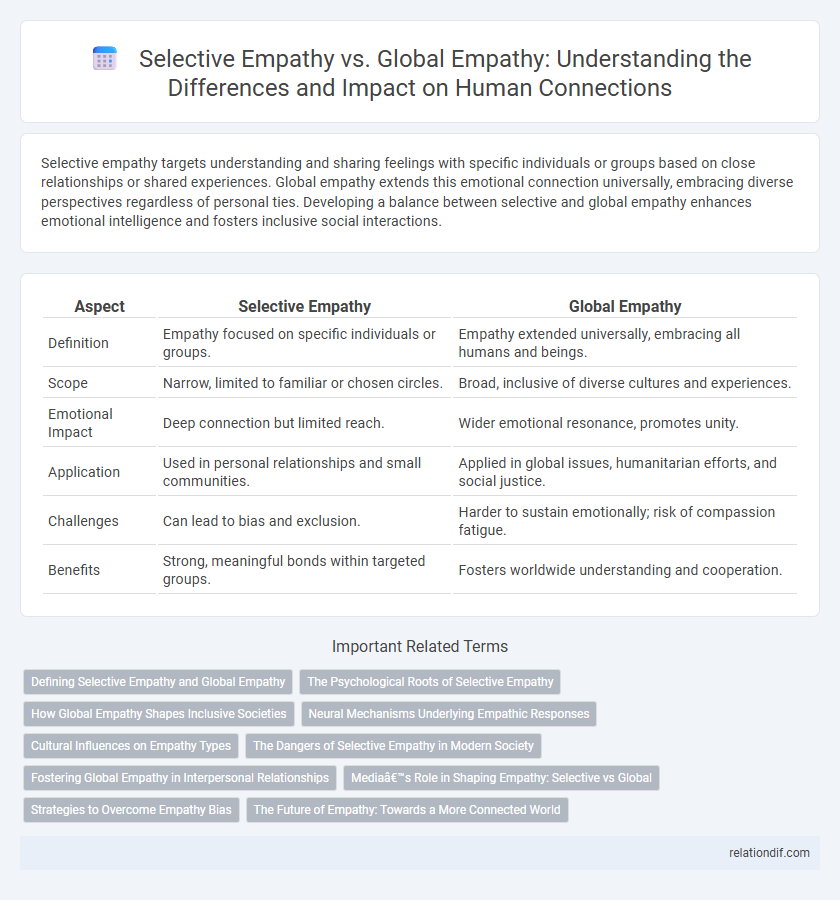Selective empathy targets understanding and sharing feelings with specific individuals or groups based on close relationships or shared experiences. Global empathy extends this emotional connection universally, embracing diverse perspectives regardless of personal ties. Developing a balance between selective and global empathy enhances emotional intelligence and fosters inclusive social interactions.
Table of Comparison
| Aspect | Selective Empathy | Global Empathy |
|---|---|---|
| Definition | Empathy focused on specific individuals or groups. | Empathy extended universally, embracing all humans and beings. |
| Scope | Narrow, limited to familiar or chosen circles. | Broad, inclusive of diverse cultures and experiences. |
| Emotional Impact | Deep connection but limited reach. | Wider emotional resonance, promotes unity. |
| Application | Used in personal relationships and small communities. | Applied in global issues, humanitarian efforts, and social justice. |
| Challenges | Can lead to bias and exclusion. | Harder to sustain emotionally; risk of compassion fatigue. |
| Benefits | Strong, meaningful bonds within targeted groups. | Fosters worldwide understanding and cooperation. |
Defining Selective Empathy and Global Empathy
Selective empathy involves understanding and sharing the feelings of specific individuals or groups based on personal connections or similarities, whereas global empathy extends this emotional resonance universally, encompassing all people regardless of differences. Selective empathy often results from close relationships or shared experiences, fostering deep emotional bonds, while global empathy requires a broader perspective, emphasizing compassion for humanity as a whole. Defining these concepts highlights how selective empathy may limit emotional investment, whereas global empathy promotes inclusivity and universal understanding.
The Psychological Roots of Selective Empathy
Selective empathy originates from evolutionary and psychological mechanisms that prioritize in-group members for resource sharing and emotional support, reinforcing social bonds critical for survival. Cognitive biases like in-group favoritism and social identity theory further amplify selective empathy by limiting emotional resonance to those perceived as similar or belonging to the same cultural, racial, or ideological group. Neural studies reveal that brain regions such as the anterior insula and anterior cingulate cortex activate more strongly when empathizing with in-group members, underscoring the biological basis of selective empathy.
How Global Empathy Shapes Inclusive Societies
Global empathy fosters inclusive societies by encouraging understanding and respect across diverse cultures, identities, and experiences. This broad empathetic approach enables individuals to recognize interconnectedness beyond personal or group boundaries, promoting social cohesion and reducing prejudice. Embracing global empathy supports collective well-being, equity, and collaborative problem-solving in increasingly multicultural environments.
Neural Mechanisms Underlying Empathic Responses
Selective empathy engages the anterior insula and anterior cingulate cortex, regions responsible for processing personal relevance and emotional salience. In contrast, global empathy recruits a broader neural network, including the medial prefrontal cortex and temporoparietal junction, facilitating perspective-taking and understanding diverse experiences. These distinct neural mechanisms underline the variability in empathic responses depending on social context and relational proximity.
Cultural Influences on Empathy Types
Cultural influences shape the development of selective and global empathy by prioritizing in-group connections or broader human experiences, respectively. Collectivist societies often promote selective empathy, emphasizing empathy towards family and community, while individualistic cultures may foster global empathy that extends beyond immediate social circles. These cultural frameworks impact how empathy is expressed, interpreted, and valued across different social contexts.
The Dangers of Selective Empathy in Modern Society
Selective empathy, which involves showing compassion only to certain groups based on biases or similarities, can perpetuate social divisions and inequality in modern society. This limited form of empathy often reinforces echo chambers and tribalism, undermining efforts toward social justice and collective well-being. The dangers of selective empathy include increased polarization, reduced cooperation across diverse communities, and the marginalization of vulnerable populations.
Fostering Global Empathy in Interpersonal Relationships
Fostering global empathy in interpersonal relationships requires prioritizing genuine understanding of diverse experiences beyond immediate social circles. Developing skills in active listening and cultural awareness enhances the ability to connect with individuals from varied backgrounds, promoting inclusivity and compassion. This approach counteracts selective empathy by encouraging unbiased emotional engagement that supports social cohesion and mutual respect.
Media’s Role in Shaping Empathy: Selective vs Global
Media significantly influences empathy by framing narratives that either promote selective empathy, focusing on specific groups or events, or global empathy, fostering understanding across diverse populations. News outlets and social platforms often highlight particular stories that resonate with their audiences, which can lead to empathy biases toward certain regions or causes. Expanding media coverage to include a broader range of perspectives encourages the development of global empathy, enhancing cross-cultural connections and societal cohesion.
Strategies to Overcome Empathy Bias
Strategies to overcome empathy bias involve consciously expanding perspective-taking beyond selective empathy, which limits emotional resonance to familiar groups, by engaging with diverse narratives and experiences to foster global empathy. Practicing mindfulness and active listening enhances awareness of personal biases, allowing individuals to cultivate a more inclusive emotional response that embraces different cultures, identities, and viewpoints. Integrating empathy training programs in education and workplaces supports the development of cognitive and affective empathy skills, promoting equitable social interactions and reducing prejudiced behavior rooted in selective empathy.
The Future of Empathy: Towards a More Connected World
Selective empathy often limits emotional engagement to familiar groups, whereas global empathy expands understanding across diverse cultures and experiences, fostering a more inclusive society. Advances in technology and education are amplifying global empathy by facilitating cross-cultural communication and shared human experiences on unprecedented scales. Embracing global empathy promises a future where collaborative problem-solving and mutual respect drive progress toward a unified, compassionate world community.
Selective Empathy vs Global Empathy Infographic

 relationdif.com
relationdif.com